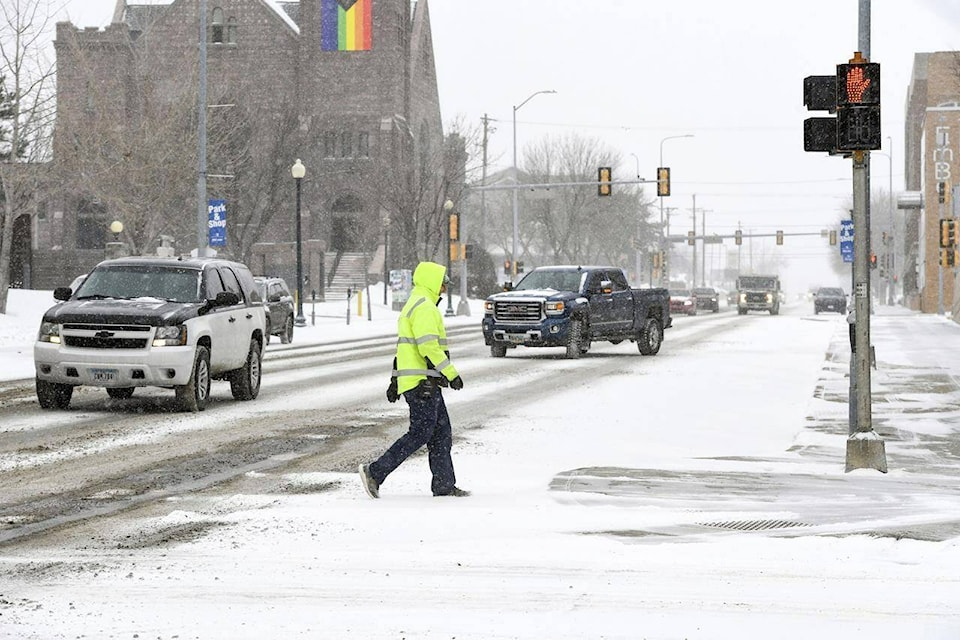A brutal winter storm knocked out power in California, closed interstate highways from Arizona to Wyoming and prompted more than 1,200 flight cancellations Wednesday — and the worst won’t be over for several days.
Few places were untouched by the wild weather, some at the opposite extreme. Record highs were forecast from the mid-Atlantic states down through Florida, with some places expected to reach up to 40 degrees above normal.
The wintry mix was hitting hardest in the northern tier of the nation. Schools throughout the Dakotas, Minnesota and Wisconsin were called off. Offices closed, as did the Minnesota Legislature. South Dakota Gov. Kristi Noem shut down state executive branch offices in several parts of the state, and employees worked remotely.
Travel was difficult. Weather contributed to more than 1,200 canceled flights across the country by midmorning, according to tracking service FlightAware. About one-third of those canceled flights — roughly 400 — were due to arrive or depart from the Minneapolis-St. Paul International Airport.
In Wyoming, virtually every road was affected.
“A major winter storm and multi-day closures are likely on Interstates and secondary roads throughout Wyoming!” the state Transportation Department said on Facebook.
It wasn’t much better in neighboring states.
“Sometimes it’s physically impossible to keep up with Mother Nature,” said North Dakota Highway Patrol Sgt. Wade Kadrmas.
He warned those who venture out to dress appropriately. Often, when motorists get stranded, “They don’t have a winter jacket. They might be wearing shorts and flip-flops, just thinking they’re going to get from point A to point B and nothing is going to go wrong,” he said.
Kelly Cross has spent his entire 60 years in South Dakota, but even he tires of the wintry weather that often spills well into spring. Besides the regular snow shoveling at his Pierre store, K&C Western Wear, he’s gone through pounds of salt to keep the walkway clear. The company of his terrier, Penny, makes the slog to work tolerable.
“She comes with me every day,” Cross said.
Jeff Lea, spokesperson for the Metropolitan Airports Commission, which operates the Minneapolis airport, said most airlines canceled flights early, so travelers would know before heading to the airport.
“I think the airlines are trying to make sure that they can, looking at the bigger picture, make those cancelations so they can better respond after the storm and make a quicker recovery,” Lea said.
In the Pacific Northwest, high winds and heavy snow in the Cascade Mountains prevented search teams from reaching the bodies of three climbers killed in an avalanche on Washington’s Colchuck Peak over the weekend. Two experts from the Northwest Avalanche Center were hiking to the scene Wednesday to determine if conditions might permit a recovery attempt later this week.
Powerful winds were the biggest problem in California, toppling trees and power lines. By Wednesday afternoon, more than 91,000 customers in the state were without electricity, according to PowerOutage.us.
A 1-year-old child was critically injured when a redwood crashed onto a home in Boulder Creek, a community in the Santa Cruz Mountains south of San Francisco, KTVU reported. Chief Mark Bingham of the local fire protection district said crews had to cut up the tree to free the victim.
A blizzard warning was issued for the mountains of Los Angeles, Ventura and Santa Barbara counties, effective from 4 a.m. Thursday to 4 p.m. Saturday, the National Weather Service said.
“Nearly the entire population of CA will be able to see snow from some vantage point later this week if they look in the right direction (i.e., toward the highest hills in vicinity),” UCLA climate scientist Daniel Swain wrote on Twitter.
A more than 200-mile (320-kilometer) stretch of Interstate 40 from central Arizona to the New Mexico line closed due to snow, ran and wind gusts of up to 80 mph (129 kph). Thousands were without power in Arizona.
In the northern U.S. — a region accustomed to heavy snow — the snowfall could be historic. More than 20 inches (50.8 centimeters) may pile up in parts of Minnesota and Wisconsin, the National Weather Service said. According to the weather service, the biggest snow event on record in the Twin Cities was 28.4 inches (72 centimeters) from Oct. 31 through Nov. 3, 1991. The second-largest was 21.1 inches (53.6 centimeters) of snow from Nov. 29 through Dec. 1, 1985.
Temperatures could plunge as low as minus 20 degrees Fahrenheit (minus 29 degrees Celsius) Thursday and to minus 25 degrees Fahrenheit (minus 32 degrees Celsius) Friday in Grand Forks, North Dakota. Wind chills may fall to minus 50 degrees Fahrenheit (minus 46 degrees Celsius), said Nathan Rick, a meteorologist in Grand Forks.
Wind gusts may reach 50 mph (80 kph) in western and central Minnesota, resulting in “significant blowing and drifting snow with whiteout conditions in open areas,” the weather service said.
The storm will make its way toward the East Coast later this week. Places that don’t get snow may get dangerous amounts of ice. Forecasters expect up to a half-inch of ice in parts of southern Michigan, northern Illinois and some eastern states.
As the northern U.S. deals with a winter blast, the mid-Atlantic and Southeast could experience record warmth Wednesday.
“We could see record highs being set everywhere from Pittsburgh to as far south as Fort Myers, Florida,” National Weather Service Meteorologist Frank Pereira said. Highs in the Southeast could reach the mid- to upper-80s.
In Fargo, North Dakota, the Wednesday morning temperature was minus 11 degrees Fahrenheit (minus 24 degrees Celsius), so server Michelle Wilson wasn’t surprised by the small crowd at the Denny’s where she works.
“When the wind picks up and you’re in a flat land like North Dakota, it’s whiteout conditions immediately,” Wilson said.
—Amancai Biraben And Jim Salter, The Associated Press
RELATED: Icy winds, snow, hit much of B.C., weekend snow possible for south coast: forecasters
